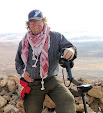So - we finished up at Siddon's Ridge yesterday with all the team working hard to complete the tasks they had started previously. Final searches, excavations, cleaning, drawing, measuring and planning all taking place to achieve as much as we could at the end of this amazing season.
Then back to the hotel on the last dark, dusty drive from site through the desert. Once cleaned up and having eaten we had a 'show and tell' session displaying some of the important finds of the season to the entire group, with lively questions and answers given as best they could be. This was followed by an overview of the project's inception and development, and a discussion of how what we had achieved fits in with the huge amount of other information we have already discovered. We then watched a copy of the programme made by National Geographic who spent some time with us last season and entitled "The Mystery Files - Lawrence of Arabia". A late but very enjoyable evening to round up the work of the season.
So - what next?
Several reconnaissance trips were made by a small team in order to assess possibilities for research in future years. The first was to the area of Mudowarra, south of Ma’an, near the present-day border with Saudi Arabia. Here, three large and heavily-fortified hill-tops were located, whose summits were surrounded by extensive dry-stone walls with numerous loopholes. These places were identified by RFC pilots in advance of, and attacked during, the famous raid by the Imperial Camel Corps on 9 August 1918, which took all three Ottoman positions. The area today is the location of a major Bedouin settlement, where the inhabitants occupy the traditional long tent and also newly-built structures. Only a few hundred metres from the fortified hills is a partly-destroyed Hajj fort which had seen some re-occupation by the Jordanian army in recent decades. The trip concluded with an assessment of the remaining Hejaz Railway buildings – two of which are today occupied by Bedouin families, one of which invited the team to share chai – interestingly in their long tent rather than the station building.
The second trip went north from Ma’an to
the isolated Hejaz Railway station of Suwaqa, where there is a two-storey
station building with two outlying defensive positions on the eastern hills.
The building is well-preserved, with an associated, and now largely destroyed, set
of mud-brick buildings – perhaps a small pre-railway village or maybe structures
for railway workers or Ottoman troops. Several hundred metres to the southeast is
the best-preserved of the outlying defences – a largely ruined bunker with a
trench running eastwards, and overlooking a multi-span railway bridge to the
west. After leaving Suwaqa the team spent some time examining the very-well
preserved Hejaz station located in the centre of the town of Qatrana. The main
station building is in excellent condition and was inhabited until recently.
The railway is still used to an extent, and there were many rail-trucks in
situ, as well as a triangular ‘passing track’ to allow trains to be manoeuvred
in and out of the station.
All these offer more opportunities to expand our investigations and understanding of this fantastic country and the way in which it's landscape, people and military authorities intertwined and were developed and shaped before, during and since the Great Arab Revolt. We will be back again next year, we hope, to continue this amazing project. Many thanks to all who have followed this blog, passed comments by word of mouth, email, text message, facebook, twitter and all other means. We hope you have enjoyed this portion of our unfolding story and that you will be back next season to discover, with us, what the next phase of this exciting project reveals.























No comments:
Post a Comment